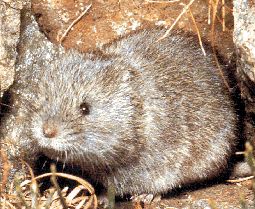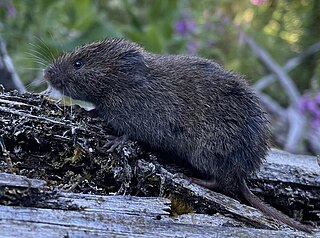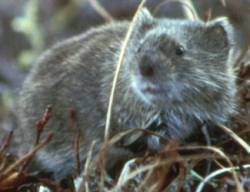
The Arvicolinae are a subfamily of rodents that includes the voles, lemmings, and muskrats. They are most closely related to the other subfamilies in the Cricetidae. Some authorities place the subfamily Arvicolinae in the family Muridae along with all other members of the superfamily Muroidea. Some refer to the subfamily as the Microtinae or rank the taxon as a full family, the Arvicolidae.

Microtus is a genus of voles found in North America, Europe and northern Asia. The genus name refers to the small ears of these animals. They are stout rodents with short ears, legs and tails. They eat green vegetation such as grasses and sedges in summer, and grains, seeds, root and bark at other times. The genus is also called "meadow voles".

Clethrionomys is a genus of small, slender voles. In recent years the genus name was changed to Myodes, however a 2019 paper found that Myodes was actually a junior synonym for Lemmus, thus making it unusable. As such, Clethrionomys is re-established as the proper genus name. At the same time, several species were moved to the genus Craseomys, so members of both genera are referred to as red-backed voles. This genus was described by Johannes von Nepomuk Franz Xaver Gistel under the pseudonym "G. Tilesius". Some authors cite the taxonomic authority as "Gistel, 1850", whereas others still use "Tilesius, 1850".

The genus Arborimus is a group of voles found in western North America. The genus name is Latin for "tree mouse". Some sources include this genus with the heather voles, genus Phenacomys, and both are classified in the tribe Phenacomyini.

Water voles are large voles in the genus Arvicola. They are found in both aquatic and dry habitat through Europe and much of northern Asia. A water vole found in Western North America was historically considered a member of this genus, but has been shown to be more closely related to members of the genus Microtus. Head and body lengths are 12–22 cm, tail lengths are 6.5–12.5 cm, and their weights are 70–250 g. The animals may exhibit indeterminate growth. They are thick-furred and have hairy fringes on their feet that improve their swimming ability.

The royal vole, also called the Korean red-backed vole, is a species of vole endemic to the Korean Peninsula. It lives underground in a burrow, emerging at night to feed on grasses, seeds and other vegetation. The International Union for Conservation of Nature has listed its conservation status as being of "least concern".

The grey red-backed vole or the grey-sided vole is a species of vole. An adult grey red-backed vole weighs 20-50 grams. This species ranges across northern Eurasia, including northern China, the northern Korean Peninsula, and the islands of Sakhalin and Hokkaidō. It is larger and longer-legged than the northern red-backed vole, which covers a similar range and it is also sympatric with the Norwegian lemming.
The white-tailed mountain vole is a species of vole in the family Cricetidae. It is found in India and Pakistan.

The silver mountain vole is a species of rodent in the family Cricetidae. They are distinguished by their silver-grey pelage, long vibrissae, rootless hypsodont molars and angular skull shape. Like many mammals of the Eurasian Steppe eco-region, they are well adapted to life in high altitudes, and can be found in mountain areas of Central Asia from Saur Mountains in the north-east to Kugitang Range in the west, and to Tibet and the Himalayas in the south.
The central Kashmir vole is a species of rodent in the family Cricetidae. In addition to Kashmir, it is found in India and Pakistan.
The Mongolian silver vole, also called the Mongolian mountain vole, is a species of rodent in the family Cricetidae. It is found mostly in Mongolia and small parts of southern Russia and northeastern China. In general, they are not crepuscular.
The flat-headed vole, also called the flat-headed mountain vole or Strelzov's mountain vole, is a species of rodent in the family Cricetidae. It is found in China, Kazakhstan, Mongolia, and Russian Federation.

Chionomys is a genus of rodent in the family Cricetidae.
The Hokkaido red-backed vole is a species of rodent in the family Cricetidae. It is found at high altitudes on the island of Hokkaido in Japan and at lower altitudes on some smaller islands nearby. Its natural habitat is temperate forests.

The creeping vole, sometimes known as the Oregon meadow mouse, is a small rodent in the family Cricetidae. Ranging across the Pacific Northwest of North America, it is found in forests, grasslands, woodlands, and chaparral environments. The small-tailed, furry, brownish-gray mammal was first described in the scientific literature in 1839, from a specimen collected near the mouth of the Columbia River. The smallest vole in its range, it weighs around 19 g. At birth, they weigh 1.6 g, are naked, pink, unable to open their eyes, and the ear flaps completely cover the ear openings. Although not always common throughout their range, there are no major concerns for their survival as a species.
The Clethrionomyini are a tribe of forest voles in the subfamily Arvicolinae. This tribe was formerly known as Myodini, but when genus Myodes was deemed to be a junior synonym, the tribe was renamed. Species in this tribe are:
Neodon is a genus of rodent in the family Cricetidae. Species within Neodon are classified as relics of the Pleistocene epoch because the occlusal patterns resemble the extinct Allophaiomys.
The Lake Baikal mountain vole or Olkhon mountain vole is a species of rodent in the family Cricetidae. It is found principally on the Olkhon and Ogoi islands on Lake Baikal, in southern Siberia. It is also found in a small part of the bordering mainland Russia, on the Baikal coast of the Irkutsk Oblast. It was originally described as a subspecies of the silver mountain vole. Since then, it has been synonymized with A. roylei in 1978, A. tuvinicus, and A. macrotis before reinstating it as a species. It is likely a sister species to A. tuvinicus.

Alexandromys is a genus of voles in the subfamily Arvicolinae, formerly a subgenus of the genus Microtus. Species in this genus are:

Microtini is a tribe of voles in the subfamily Arvicolinae.




















